Obstacles to Women’s Career Progress at Workplace
VerifiedAdded on 2023/01/11
|10
|2548
|66
AI Summary
This research project aims to determine the obstacles to career progress of women at workplace, with a case study on British Broadcasting Corporation (BBC). It explores the concept of gender inequality, assesses the barriers women face in their career progression, and identifies ways that management can overcome these barriers.
Contribute Materials
Your contribution can guide someone’s learning journey. Share your
documents today.
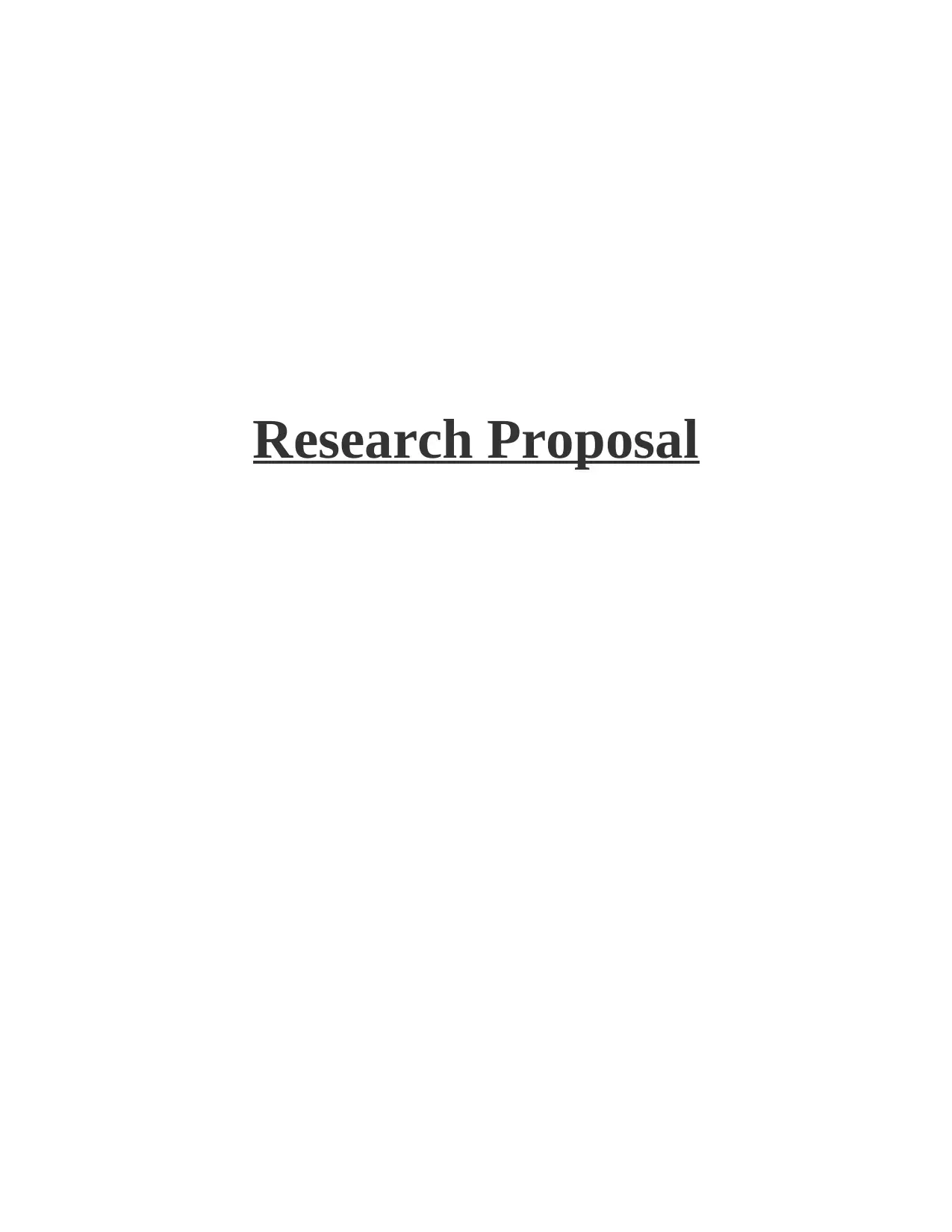
Research Proposal
Secure Best Marks with AI Grader
Need help grading? Try our AI Grader for instant feedback on your assignments.

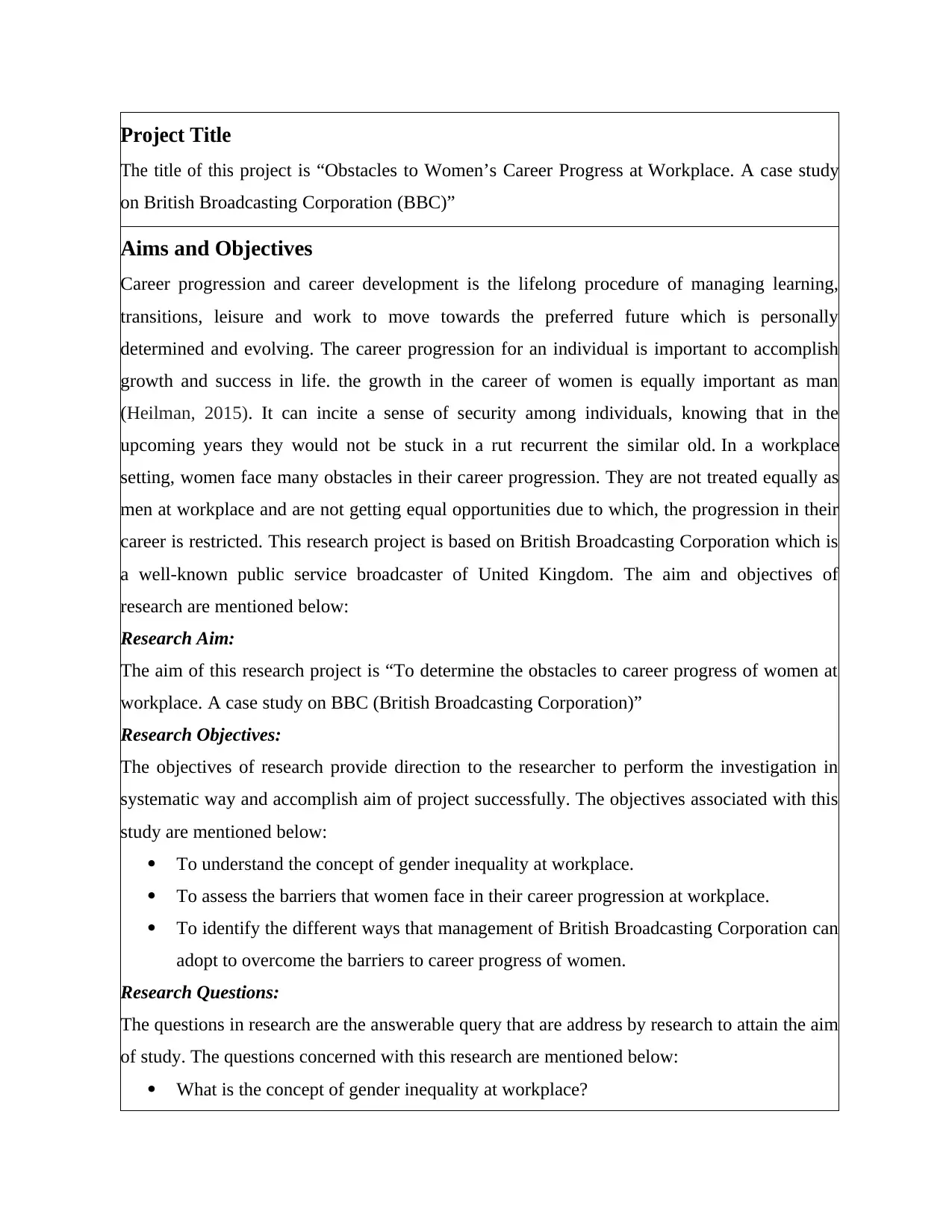
Project Title
The title of this project is “Obstacles to Women’s Career Progress at Workplace. A case study
on British Broadcasting Corporation (BBC)”
Aims and Objectives
Career progression and career development is the lifelong procedure of managing learning,
transitions, leisure and work to move towards the preferred future which is personally
determined and evolving. The career progression for an individual is important to accomplish
growth and success in life. the growth in the career of women is equally important as man
(Heilman, 2015). It can incite a sense of security among individuals, knowing that in the
upcoming years they would not be stuck in a rut recurrent the similar old. In a workplace
setting, women face many obstacles in their career progression. They are not treated equally as
men at workplace and are not getting equal opportunities due to which, the progression in their
career is restricted. This research project is based on British Broadcasting Corporation which is
a well-known public service broadcaster of United Kingdom. The aim and objectives of
research are mentioned below:
Research Aim:
The aim of this research project is “To determine the obstacles to career progress of women at
workplace. A case study on BBC (British Broadcasting Corporation)”
Research Objectives:
The objectives of research provide direction to the researcher to perform the investigation in
systematic way and accomplish aim of project successfully. The objectives associated with this
study are mentioned below:
To understand the concept of gender inequality at workplace.
To assess the barriers that women face in their career progression at workplace.
To identify the different ways that management of British Broadcasting Corporation can
adopt to overcome the barriers to career progress of women.
Research Questions:
The questions in research are the answerable query that are address by research to attain the aim
of study. The questions concerned with this research are mentioned below:
What is the concept of gender inequality at workplace?
The title of this project is “Obstacles to Women’s Career Progress at Workplace. A case study
on British Broadcasting Corporation (BBC)”
Aims and Objectives
Career progression and career development is the lifelong procedure of managing learning,
transitions, leisure and work to move towards the preferred future which is personally
determined and evolving. The career progression for an individual is important to accomplish
growth and success in life. the growth in the career of women is equally important as man
(Heilman, 2015). It can incite a sense of security among individuals, knowing that in the
upcoming years they would not be stuck in a rut recurrent the similar old. In a workplace
setting, women face many obstacles in their career progression. They are not treated equally as
men at workplace and are not getting equal opportunities due to which, the progression in their
career is restricted. This research project is based on British Broadcasting Corporation which is
a well-known public service broadcaster of United Kingdom. The aim and objectives of
research are mentioned below:
Research Aim:
The aim of this research project is “To determine the obstacles to career progress of women at
workplace. A case study on BBC (British Broadcasting Corporation)”
Research Objectives:
The objectives of research provide direction to the researcher to perform the investigation in
systematic way and accomplish aim of project successfully. The objectives associated with this
study are mentioned below:
To understand the concept of gender inequality at workplace.
To assess the barriers that women face in their career progression at workplace.
To identify the different ways that management of British Broadcasting Corporation can
adopt to overcome the barriers to career progress of women.
Research Questions:
The questions in research are the answerable query that are address by research to attain the aim
of study. The questions concerned with this research are mentioned below:
What is the concept of gender inequality at workplace?
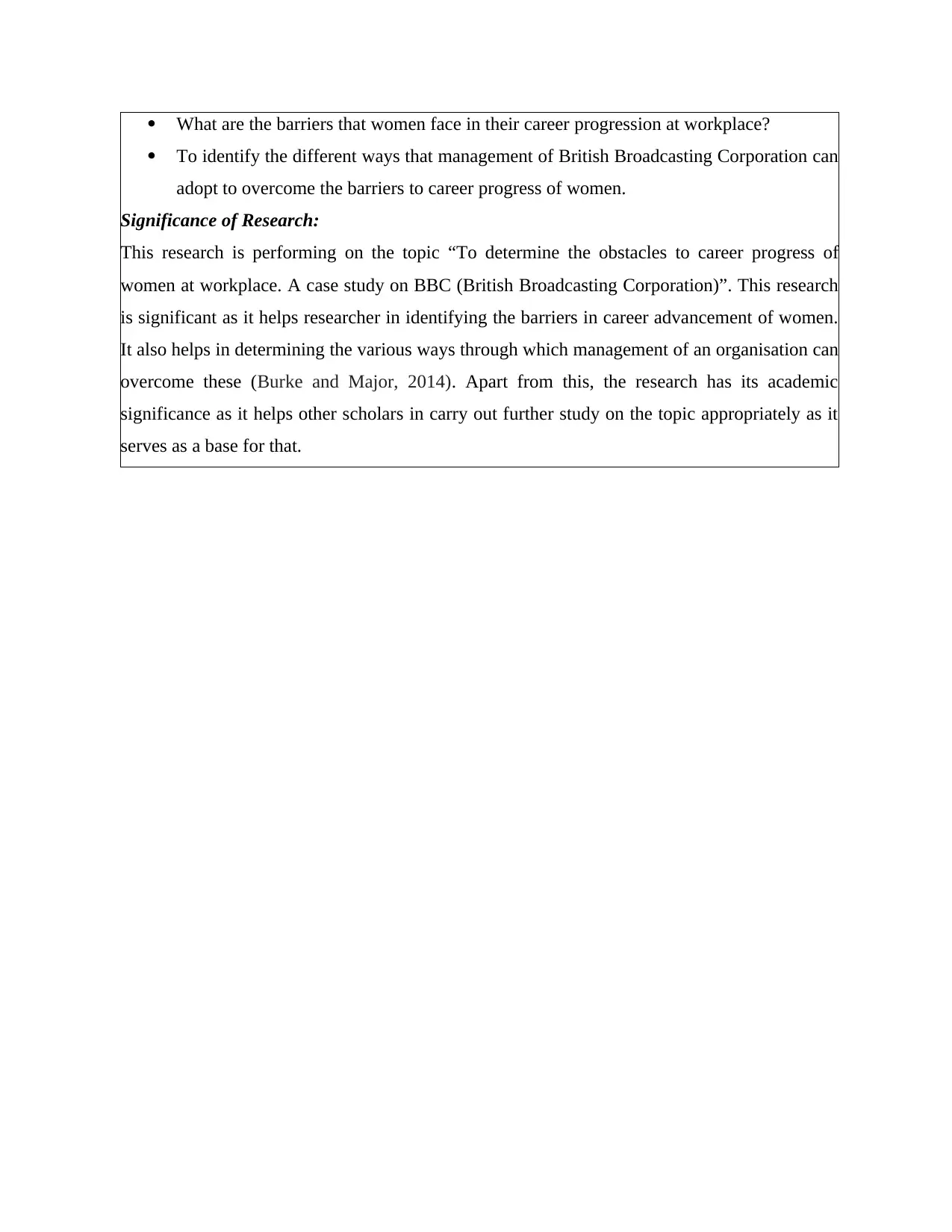
What are the barriers that women face in their career progression at workplace?
To identify the different ways that management of British Broadcasting Corporation can
adopt to overcome the barriers to career progress of women.
Significance of Research:
This research is performing on the topic “To determine the obstacles to career progress of
women at workplace. A case study on BBC (British Broadcasting Corporation)”. This research
is significant as it helps researcher in identifying the barriers in career advancement of women.
It also helps in determining the various ways through which management of an organisation can
overcome these (Burke and Major, 2014). Apart from this, the research has its academic
significance as it helps other scholars in carry out further study on the topic appropriately as it
serves as a base for that.
To identify the different ways that management of British Broadcasting Corporation can
adopt to overcome the barriers to career progress of women.
Significance of Research:
This research is performing on the topic “To determine the obstacles to career progress of
women at workplace. A case study on BBC (British Broadcasting Corporation)”. This research
is significant as it helps researcher in identifying the barriers in career advancement of women.
It also helps in determining the various ways through which management of an organisation can
overcome these (Burke and Major, 2014). Apart from this, the research has its academic
significance as it helps other scholars in carry out further study on the topic appropriately as it
serves as a base for that.
Secure Best Marks with AI Grader
Need help grading? Try our AI Grader for instant feedback on your assignments.
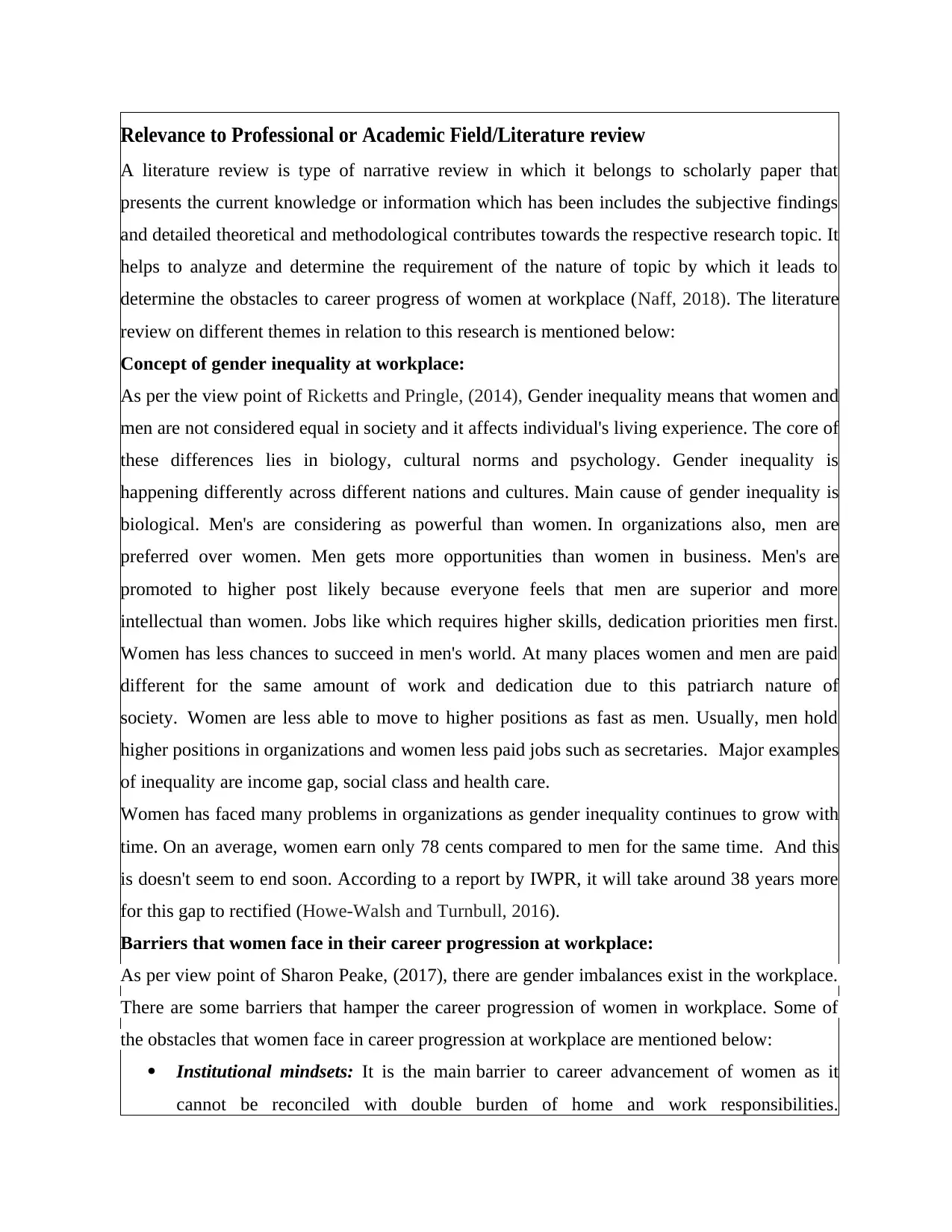
Relevance to Professional or Academic Field/Literature review
A literature review is type of narrative review in which it belongs to scholarly paper that
presents the current knowledge or information which has been includes the subjective findings
and detailed theoretical and methodological contributes towards the respective research topic. It
helps to analyze and determine the requirement of the nature of topic by which it leads to
determine the obstacles to career progress of women at workplace (Naff, 2018). The literature
review on different themes in relation to this research is mentioned below:
Concept of gender inequality at workplace:
As per the view point of Ricketts and Pringle, (2014), Gender inequality means that women and
men are not considered equal in society and it affects individual's living experience. The core of
these differences lies in biology, cultural norms and psychology. Gender inequality is
happening differently across different nations and cultures. Main cause of gender inequality is
biological. Men's are considering as powerful than women. In organizations also, men are
preferred over women. Men gets more opportunities than women in business. Men's are
promoted to higher post likely because everyone feels that men are superior and more
intellectual than women. Jobs like which requires higher skills, dedication priorities men first.
Women has less chances to succeed in men's world. At many places women and men are paid
different for the same amount of work and dedication due to this patriarch nature of
society. Women are less able to move to higher positions as fast as men. Usually, men hold
higher positions in organizations and women less paid jobs such as secretaries. Major examples
of inequality are income gap, social class and health care.
Women has faced many problems in organizations as gender inequality continues to grow with
time. On an average, women earn only 78 cents compared to men for the same time. And this
is doesn't seem to end soon. According to a report by IWPR, it will take around 38 years more
for this gap to rectified (Howe-Walsh and Turnbull, 2016).
Barriers that women face in their career progression at workplace:
As per view point of Sharon Peake, (2017), there are gender imbalances exist in the workplace.
There are some barriers that hamper the career progression of women in workplace. Some of
the obstacles that women face in career progression at workplace are mentioned below:
Institutional mindsets: It is the main barrier to career advancement of women as it
cannot be reconciled with double burden of home and work responsibilities.
A literature review is type of narrative review in which it belongs to scholarly paper that
presents the current knowledge or information which has been includes the subjective findings
and detailed theoretical and methodological contributes towards the respective research topic. It
helps to analyze and determine the requirement of the nature of topic by which it leads to
determine the obstacles to career progress of women at workplace (Naff, 2018). The literature
review on different themes in relation to this research is mentioned below:
Concept of gender inequality at workplace:
As per the view point of Ricketts and Pringle, (2014), Gender inequality means that women and
men are not considered equal in society and it affects individual's living experience. The core of
these differences lies in biology, cultural norms and psychology. Gender inequality is
happening differently across different nations and cultures. Main cause of gender inequality is
biological. Men's are considering as powerful than women. In organizations also, men are
preferred over women. Men gets more opportunities than women in business. Men's are
promoted to higher post likely because everyone feels that men are superior and more
intellectual than women. Jobs like which requires higher skills, dedication priorities men first.
Women has less chances to succeed in men's world. At many places women and men are paid
different for the same amount of work and dedication due to this patriarch nature of
society. Women are less able to move to higher positions as fast as men. Usually, men hold
higher positions in organizations and women less paid jobs such as secretaries. Major examples
of inequality are income gap, social class and health care.
Women has faced many problems in organizations as gender inequality continues to grow with
time. On an average, women earn only 78 cents compared to men for the same time. And this
is doesn't seem to end soon. According to a report by IWPR, it will take around 38 years more
for this gap to rectified (Howe-Walsh and Turnbull, 2016).
Barriers that women face in their career progression at workplace:
As per view point of Sharon Peake, (2017), there are gender imbalances exist in the workplace.
There are some barriers that hamper the career progression of women in workplace. Some of
the obstacles that women face in career progression at workplace are mentioned below:
Institutional mindsets: It is the main barrier to career advancement of women as it
cannot be reconciled with double burden of home and work responsibilities.
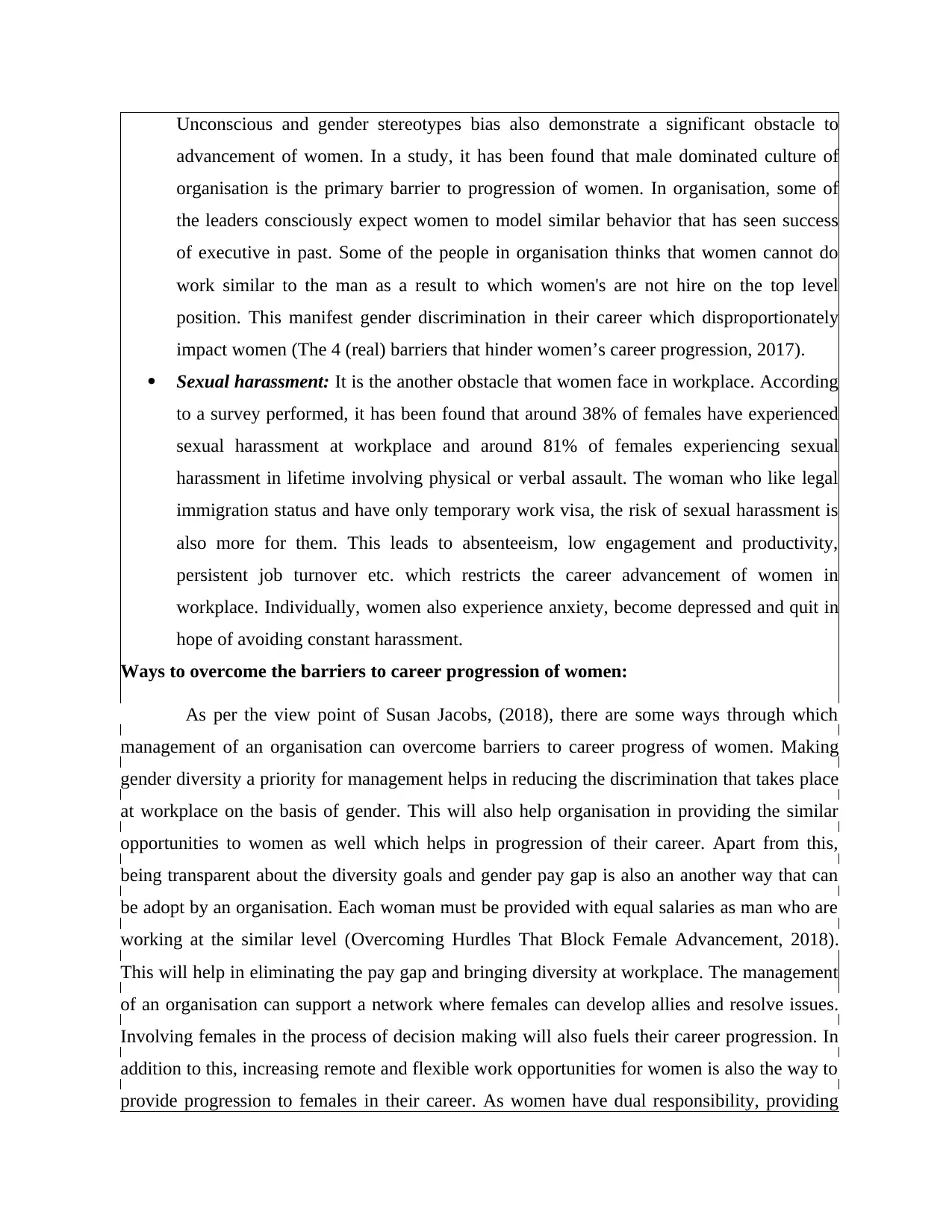
Unconscious and gender stereotypes bias also demonstrate a significant obstacle to
advancement of women. In a study, it has been found that male dominated culture of
organisation is the primary barrier to progression of women. In organisation, some of
the leaders consciously expect women to model similar behavior that has seen success
of executive in past. Some of the people in organisation thinks that women cannot do
work similar to the man as a result to which women's are not hire on the top level
position. This manifest gender discrimination in their career which disproportionately
impact women (The 4 (real) barriers that hinder women’s career progression, 2017).
Sexual harassment: It is the another obstacle that women face in workplace. According
to a survey performed, it has been found that around 38% of females have experienced
sexual harassment at workplace and around 81% of females experiencing sexual
harassment in lifetime involving physical or verbal assault. The woman who like legal
immigration status and have only temporary work visa, the risk of sexual harassment is
also more for them. This leads to absenteeism, low engagement and productivity,
persistent job turnover etc. which restricts the career advancement of women in
workplace. Individually, women also experience anxiety, become depressed and quit in
hope of avoiding constant harassment.
Ways to overcome the barriers to career progression of women:
As per the view point of Susan Jacobs, (2018), there are some ways through which
management of an organisation can overcome barriers to career progress of women. Making
gender diversity a priority for management helps in reducing the discrimination that takes place
at workplace on the basis of gender. This will also help organisation in providing the similar
opportunities to women as well which helps in progression of their career. Apart from this,
being transparent about the diversity goals and gender pay gap is also an another way that can
be adopt by an organisation. Each woman must be provided with equal salaries as man who are
working at the similar level (Overcoming Hurdles That Block Female Advancement, 2018).
This will help in eliminating the pay gap and bringing diversity at workplace. The management
of an organisation can support a network where females can develop allies and resolve issues.
Involving females in the process of decision making will also fuels their career progression. In
addition to this, increasing remote and flexible work opportunities for women is also the way to
provide progression to females in their career. As women have dual responsibility, providing
advancement of women. In a study, it has been found that male dominated culture of
organisation is the primary barrier to progression of women. In organisation, some of
the leaders consciously expect women to model similar behavior that has seen success
of executive in past. Some of the people in organisation thinks that women cannot do
work similar to the man as a result to which women's are not hire on the top level
position. This manifest gender discrimination in their career which disproportionately
impact women (The 4 (real) barriers that hinder women’s career progression, 2017).
Sexual harassment: It is the another obstacle that women face in workplace. According
to a survey performed, it has been found that around 38% of females have experienced
sexual harassment at workplace and around 81% of females experiencing sexual
harassment in lifetime involving physical or verbal assault. The woman who like legal
immigration status and have only temporary work visa, the risk of sexual harassment is
also more for them. This leads to absenteeism, low engagement and productivity,
persistent job turnover etc. which restricts the career advancement of women in
workplace. Individually, women also experience anxiety, become depressed and quit in
hope of avoiding constant harassment.
Ways to overcome the barriers to career progression of women:
As per the view point of Susan Jacobs, (2018), there are some ways through which
management of an organisation can overcome barriers to career progress of women. Making
gender diversity a priority for management helps in reducing the discrimination that takes place
at workplace on the basis of gender. This will also help organisation in providing the similar
opportunities to women as well which helps in progression of their career. Apart from this,
being transparent about the diversity goals and gender pay gap is also an another way that can
be adopt by an organisation. Each woman must be provided with equal salaries as man who are
working at the similar level (Overcoming Hurdles That Block Female Advancement, 2018).
This will help in eliminating the pay gap and bringing diversity at workplace. The management
of an organisation can support a network where females can develop allies and resolve issues.
Involving females in the process of decision making will also fuels their career progression. In
addition to this, increasing remote and flexible work opportunities for women is also the way to
provide progression to females in their career. As women have dual responsibility, providing
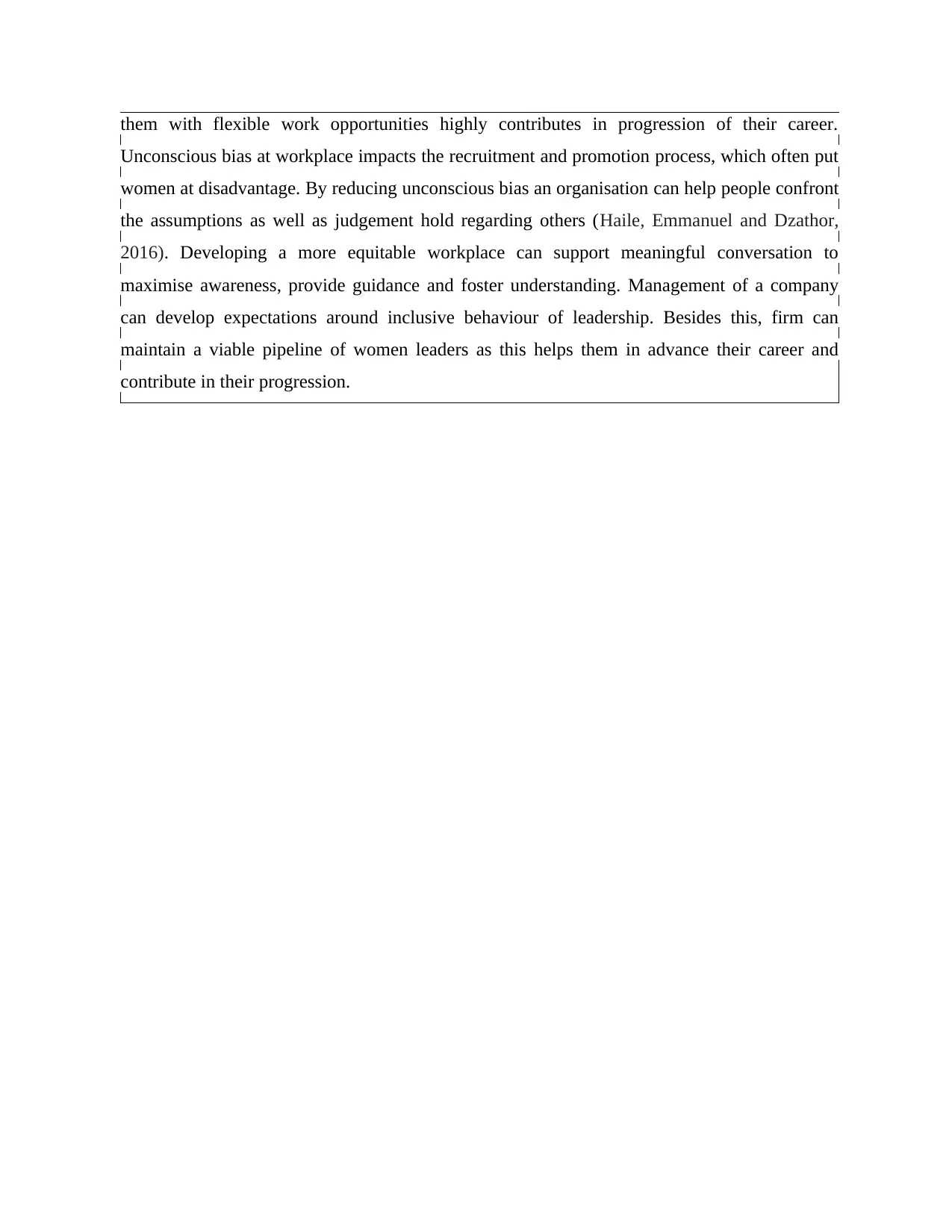
them with flexible work opportunities highly contributes in progression of their career.
Unconscious bias at workplace impacts the recruitment and promotion process, which often put
women at disadvantage. By reducing unconscious bias an organisation can help people confront
the assumptions as well as judgement hold regarding others (Haile, Emmanuel and Dzathor,
2016). Developing a more equitable workplace can support meaningful conversation to
maximise awareness, provide guidance and foster understanding. Management of a company
can develop expectations around inclusive behaviour of leadership. Besides this, firm can
maintain a viable pipeline of women leaders as this helps them in advance their career and
contribute in their progression.
Unconscious bias at workplace impacts the recruitment and promotion process, which often put
women at disadvantage. By reducing unconscious bias an organisation can help people confront
the assumptions as well as judgement hold regarding others (Haile, Emmanuel and Dzathor,
2016). Developing a more equitable workplace can support meaningful conversation to
maximise awareness, provide guidance and foster understanding. Management of a company
can develop expectations around inclusive behaviour of leadership. Besides this, firm can
maintain a viable pipeline of women leaders as this helps them in advance their career and
contribute in their progression.
Paraphrase This Document
Need a fresh take? Get an instant paraphrase of this document with our AI Paraphraser
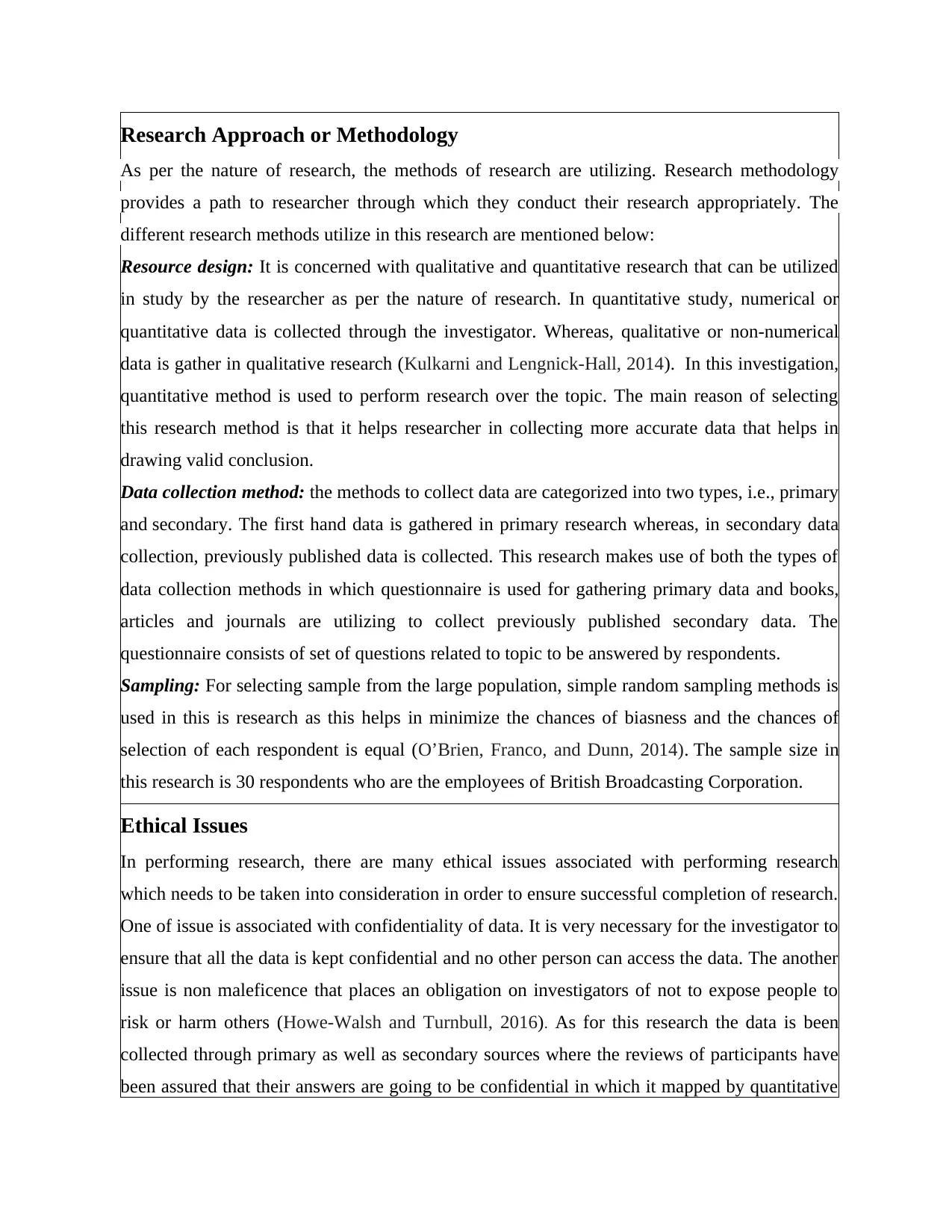
Research Approach or Methodology
As per the nature of research, the methods of research are utilizing. Research methodology
provides a path to researcher through which they conduct their research appropriately. The
different research methods utilize in this research are mentioned below:
Resource design: It is concerned with qualitative and quantitative research that can be utilized
in study by the researcher as per the nature of research. In quantitative study, numerical or
quantitative data is collected through the investigator. Whereas, qualitative or non-numerical
data is gather in qualitative research (Kulkarni and Lengnick-Hall, 2014). In this investigation,
quantitative method is used to perform research over the topic. The main reason of selecting
this research method is that it helps researcher in collecting more accurate data that helps in
drawing valid conclusion.
Data collection method: the methods to collect data are categorized into two types, i.e., primary
and secondary. The first hand data is gathered in primary research whereas, in secondary data
collection, previously published data is collected. This research makes use of both the types of
data collection methods in which questionnaire is used for gathering primary data and books,
articles and journals are utilizing to collect previously published secondary data. The
questionnaire consists of set of questions related to topic to be answered by respondents.
Sampling: For selecting sample from the large population, simple random sampling methods is
used in this is research as this helps in minimize the chances of biasness and the chances of
selection of each respondent is equal (O’Brien, Franco, and Dunn, 2014). The sample size in
this research is 30 respondents who are the employees of British Broadcasting Corporation.
Ethical Issues
In performing research, there are many ethical issues associated with performing research
which needs to be taken into consideration in order to ensure successful completion of research.
One of issue is associated with confidentiality of data. It is very necessary for the investigator to
ensure that all the data is kept confidential and no other person can access the data. The another
issue is non maleficence that places an obligation on investigators of not to expose people to
risk or harm others (Howe-Walsh and Turnbull, 2016). As for this research the data is been
collected through primary as well as secondary sources where the reviews of participants have
been assured that their answers are going to be confidential in which it mapped by quantitative
As per the nature of research, the methods of research are utilizing. Research methodology
provides a path to researcher through which they conduct their research appropriately. The
different research methods utilize in this research are mentioned below:
Resource design: It is concerned with qualitative and quantitative research that can be utilized
in study by the researcher as per the nature of research. In quantitative study, numerical or
quantitative data is collected through the investigator. Whereas, qualitative or non-numerical
data is gather in qualitative research (Kulkarni and Lengnick-Hall, 2014). In this investigation,
quantitative method is used to perform research over the topic. The main reason of selecting
this research method is that it helps researcher in collecting more accurate data that helps in
drawing valid conclusion.
Data collection method: the methods to collect data are categorized into two types, i.e., primary
and secondary. The first hand data is gathered in primary research whereas, in secondary data
collection, previously published data is collected. This research makes use of both the types of
data collection methods in which questionnaire is used for gathering primary data and books,
articles and journals are utilizing to collect previously published secondary data. The
questionnaire consists of set of questions related to topic to be answered by respondents.
Sampling: For selecting sample from the large population, simple random sampling methods is
used in this is research as this helps in minimize the chances of biasness and the chances of
selection of each respondent is equal (O’Brien, Franco, and Dunn, 2014). The sample size in
this research is 30 respondents who are the employees of British Broadcasting Corporation.
Ethical Issues
In performing research, there are many ethical issues associated with performing research
which needs to be taken into consideration in order to ensure successful completion of research.
One of issue is associated with confidentiality of data. It is very necessary for the investigator to
ensure that all the data is kept confidential and no other person can access the data. The another
issue is non maleficence that places an obligation on investigators of not to expose people to
risk or harm others (Howe-Walsh and Turnbull, 2016). As for this research the data is been
collected through primary as well as secondary sources where the reviews of participants have
been assured that their answers are going to be confidential in which it mapped by quantitative
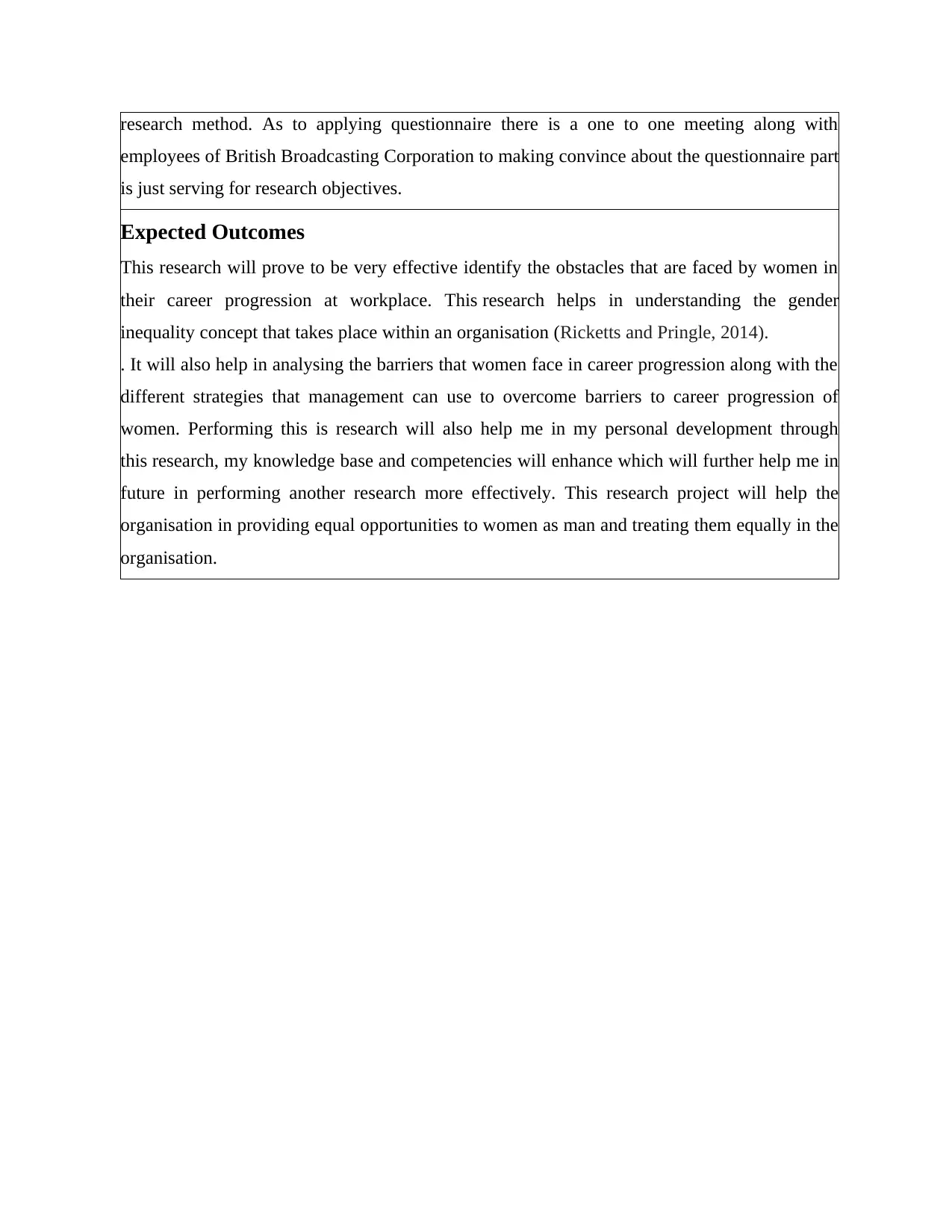
research method. As to applying questionnaire there is a one to one meeting along with
employees of British Broadcasting Corporation to making convince about the questionnaire part
is just serving for research objectives.
Expected Outcomes
This research will prove to be very effective identify the obstacles that are faced by women in
their career progression at workplace. This research helps in understanding the gender
inequality concept that takes place within an organisation (Ricketts and Pringle, 2014).
. It will also help in analysing the barriers that women face in career progression along with the
different strategies that management can use to overcome barriers to career progression of
women. Performing this is research will also help me in my personal development through
this research, my knowledge base and competencies will enhance which will further help me in
future in performing another research more effectively. This research project will help the
organisation in providing equal opportunities to women as man and treating them equally in the
organisation.
employees of British Broadcasting Corporation to making convince about the questionnaire part
is just serving for research objectives.
Expected Outcomes
This research will prove to be very effective identify the obstacles that are faced by women in
their career progression at workplace. This research helps in understanding the gender
inequality concept that takes place within an organisation (Ricketts and Pringle, 2014).
. It will also help in analysing the barriers that women face in career progression along with the
different strategies that management can use to overcome barriers to career progression of
women. Performing this is research will also help me in my personal development through
this research, my knowledge base and competencies will enhance which will further help me in
future in performing another research more effectively. This research project will help the
organisation in providing equal opportunities to women as man and treating them equally in the
organisation.
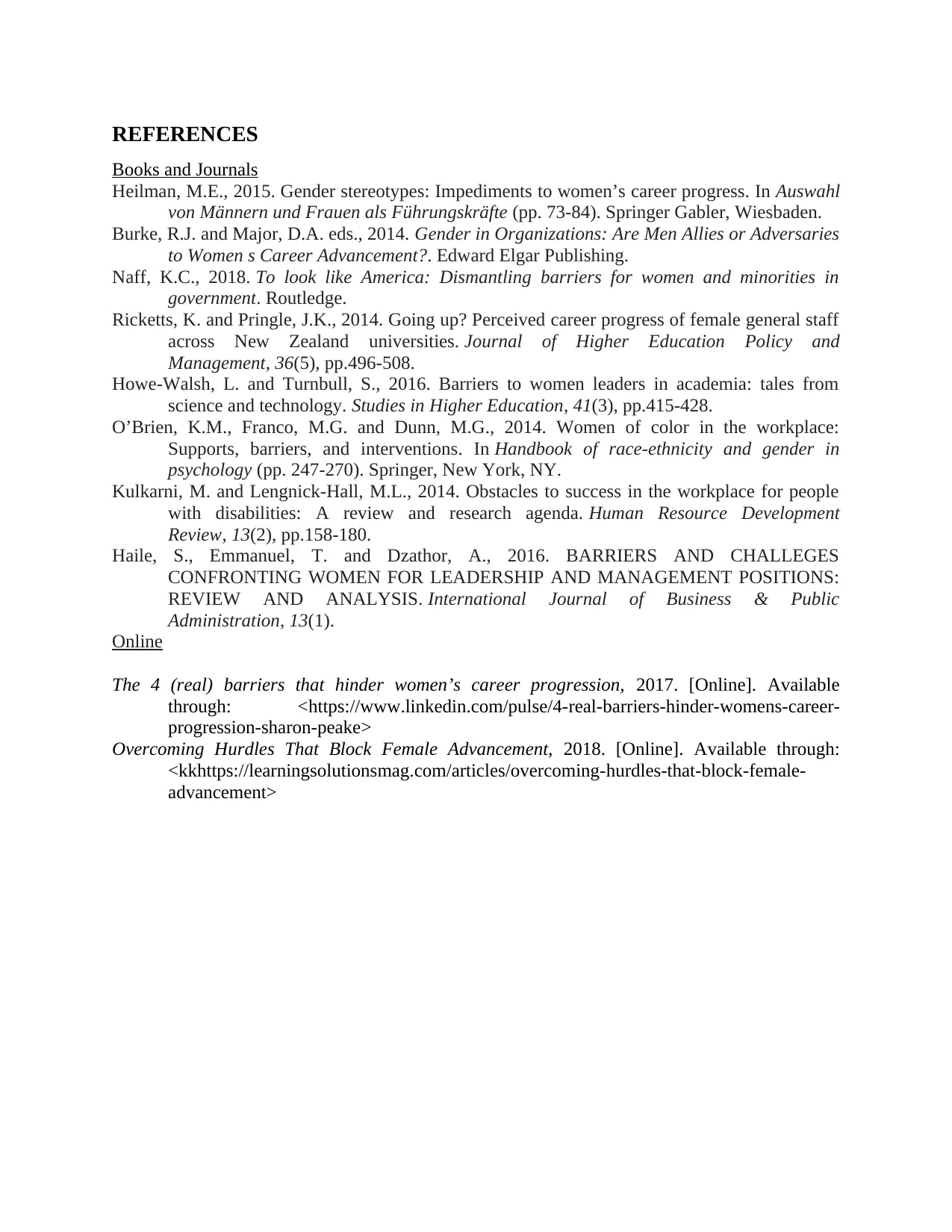
REFERENCES
Books and Journals
Heilman, M.E., 2015. Gender stereotypes: Impediments to women’s career progress. In Auswahl
von Männern und Frauen als Führungskräfte (pp. 73-84). Springer Gabler, Wiesbaden.
Burke, R.J. and Major, D.A. eds., 2014. Gender in Organizations: Are Men Allies or Adversaries
to Women s Career Advancement?. Edward Elgar Publishing.
Naff, K.C., 2018. To look like America: Dismantling barriers for women and minorities in
government. Routledge.
Ricketts, K. and Pringle, J.K., 2014. Going up? Perceived career progress of female general staff
across New Zealand universities. Journal of Higher Education Policy and
Management, 36(5), pp.496-508.
Howe-Walsh, L. and Turnbull, S., 2016. Barriers to women leaders in academia: tales from
science and technology. Studies in Higher Education, 41(3), pp.415-428.
O’Brien, K.M., Franco, M.G. and Dunn, M.G., 2014. Women of color in the workplace:
Supports, barriers, and interventions. In Handbook of race-ethnicity and gender in
psychology (pp. 247-270). Springer, New York, NY.
Kulkarni, M. and Lengnick-Hall, M.L., 2014. Obstacles to success in the workplace for people
with disabilities: A review and research agenda. Human Resource Development
Review, 13(2), pp.158-180.
Haile, S., Emmanuel, T. and Dzathor, A., 2016. BARRIERS AND CHALLEGES
CONFRONTING WOMEN FOR LEADERSHIP AND MANAGEMENT POSITIONS:
REVIEW AND ANALYSIS. International Journal of Business & Public
Administration, 13(1).
Online
The 4 (real) barriers that hinder women’s career progression, 2017. [Online]. Available
through: <https://www.linkedin.com/pulse/4-real-barriers-hinder-womens-career-
progression-sharon-peake>
Overcoming Hurdles That Block Female Advancement, 2018. [Online]. Available through:
<kkhttps://learningsolutionsmag.com/articles/overcoming-hurdles-that-block-female-
advancement>
Books and Journals
Heilman, M.E., 2015. Gender stereotypes: Impediments to women’s career progress. In Auswahl
von Männern und Frauen als Führungskräfte (pp. 73-84). Springer Gabler, Wiesbaden.
Burke, R.J. and Major, D.A. eds., 2014. Gender in Organizations: Are Men Allies or Adversaries
to Women s Career Advancement?. Edward Elgar Publishing.
Naff, K.C., 2018. To look like America: Dismantling barriers for women and minorities in
government. Routledge.
Ricketts, K. and Pringle, J.K., 2014. Going up? Perceived career progress of female general staff
across New Zealand universities. Journal of Higher Education Policy and
Management, 36(5), pp.496-508.
Howe-Walsh, L. and Turnbull, S., 2016. Barriers to women leaders in academia: tales from
science and technology. Studies in Higher Education, 41(3), pp.415-428.
O’Brien, K.M., Franco, M.G. and Dunn, M.G., 2014. Women of color in the workplace:
Supports, barriers, and interventions. In Handbook of race-ethnicity and gender in
psychology (pp. 247-270). Springer, New York, NY.
Kulkarni, M. and Lengnick-Hall, M.L., 2014. Obstacles to success in the workplace for people
with disabilities: A review and research agenda. Human Resource Development
Review, 13(2), pp.158-180.
Haile, S., Emmanuel, T. and Dzathor, A., 2016. BARRIERS AND CHALLEGES
CONFRONTING WOMEN FOR LEADERSHIP AND MANAGEMENT POSITIONS:
REVIEW AND ANALYSIS. International Journal of Business & Public
Administration, 13(1).
Online
The 4 (real) barriers that hinder women’s career progression, 2017. [Online]. Available
through: <https://www.linkedin.com/pulse/4-real-barriers-hinder-womens-career-
progression-sharon-peake>
Overcoming Hurdles That Block Female Advancement, 2018. [Online]. Available through:
<kkhttps://learningsolutionsmag.com/articles/overcoming-hurdles-that-block-female-
advancement>
1 out of 10
Related Documents
Your All-in-One AI-Powered Toolkit for Academic Success.
+13062052269
info@desklib.com
Available 24*7 on WhatsApp / Email
![[object Object]](/_next/static/media/star-bottom.7253800d.svg)
Unlock your academic potential
© 2024 | Zucol Services PVT LTD | All rights reserved.





